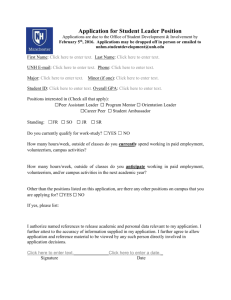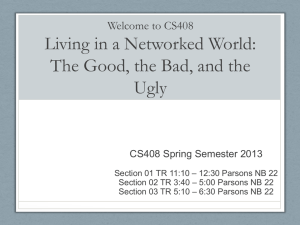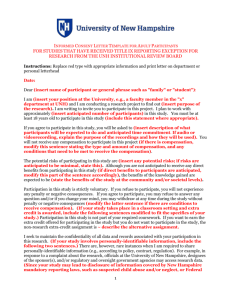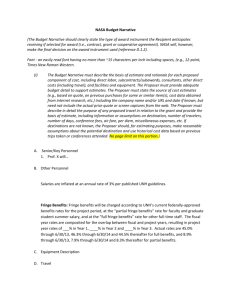Linking - 2015 AGU Fall Meeting
advertisement
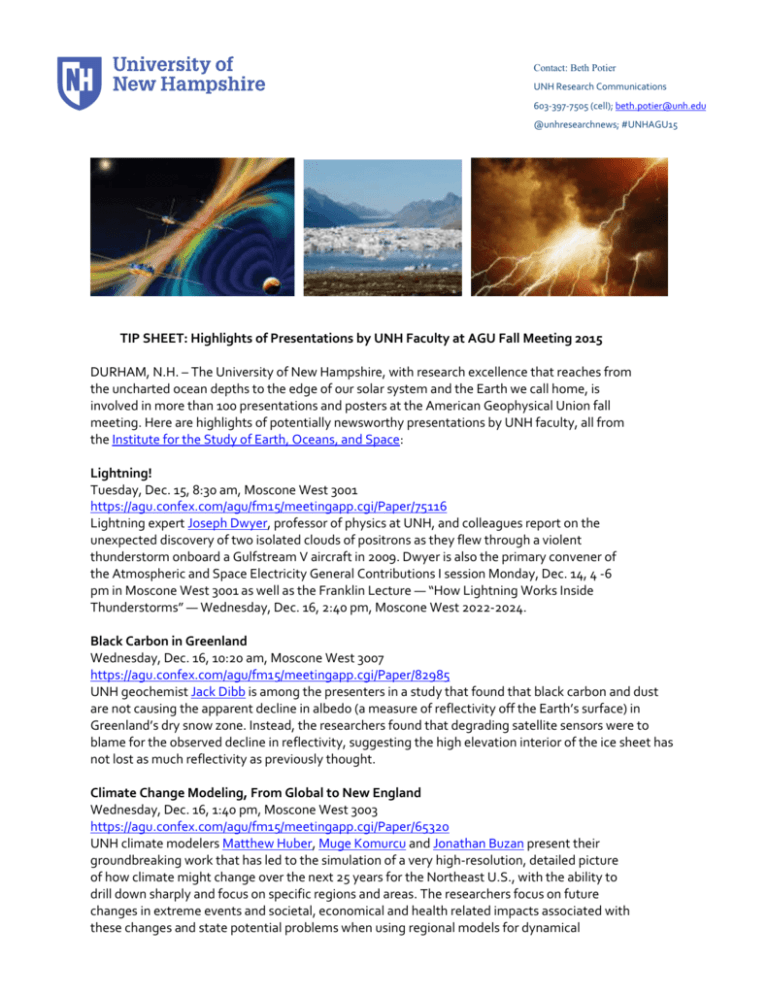
Contact: Beth Potier UNH Research Communications 603-397-7505 (cell); beth.potier@unh.edu @unhresearchnews; #UNHAGU15 TIP SHEET: Highlights of Presentations by UNH Faculty at AGU Fall Meeting 2015 DURHAM, N.H. – The University of New Hampshire, with research excellence that reaches from the uncharted ocean depths to the edge of our solar system and the Earth we call home, is involved in more than 100 presentations and posters at the American Geophysical Union fall meeting. Here are highlights of potentially newsworthy presentations by UNH faculty, all from the Institute for the Study of Earth, Oceans, and Space: Lightning! Tuesday, Dec. 15, 8:30 am, Moscone West 3001 https://agu.confex.com/agu/fm15/meetingapp.cgi/Paper/75116 Lightning expert Joseph Dwyer, professor of physics at UNH, and colleagues report on the unexpected discovery of two isolated clouds of positrons as they flew through a violent thunderstorm onboard a Gulfstream V aircraft in 2009. Dwyer is also the primary convener of the Atmospheric and Space Electricity General Contributions I session Monday, Dec. 14, 4 -6 pm in Moscone West 3001 as well as the Franklin Lecture — “How Lightning Works Inside Thunderstorms” — Wednesday, Dec. 16, 2:40 pm, Moscone West 2022-2024. Black Carbon in Greenland Wednesday, Dec. 16, 10:20 am, Moscone West 3007 https://agu.confex.com/agu/fm15/meetingapp.cgi/Paper/82985 UNH geochemist Jack Dibb is among the presenters in a study that found that black carbon and dust are not causing the apparent decline in albedo (a measure of reflectivity off the Earth’s surface) in Greenland’s dry snow zone. Instead, the researchers found that degrading satellite sensors were to blame for the observed decline in reflectivity, suggesting the high elevation interior of the ice sheet has not lost as much reflectivity as previously thought. Climate Change Modeling, From Global to New England Wednesday, Dec. 16, 1:40 pm, Moscone West 3003 https://agu.confex.com/agu/fm15/meetingapp.cgi/Paper/65320 UNH climate modelers Matthew Huber, Muge Komurcu and Jonathan Buzan present their groundbreaking work that has led to the simulation of a very high-resolution, detailed picture of how climate might change over the next 25 years for the Northeast U.S., with the ability to drill down sharply and focus on specific regions and areas. The researchers focus on future changes in extreme events and societal, economical and health related impacts associated with these changes and state potential problems when using regional models for dynamical downscaling. Their results can be utilized to improve regional sustainability and adaptation strategies in New England. This presentation leads the Linking Downscaled Climate Variables to Extreme Events, Land Surface Hydrology, Ecosystems, Ecosystem Services, and Human Health sessions Wednesday, Dec. 16 at 1:40, of which Komurcu is primary convener. Coastal Adaptation to Climate Change Wednesday, Dec. 16, 3:10, Moscone South 103 https://agu.confex.com/agu/fm15/meetingapp.cgi/Paper/62890 UNH climatologist Cameron Wake describes efforts of the NH Coastal Adaptation Workgroup, a grassroots climate adaptation effort that’s united 21 government agencies, businesses, academics and municipalities to address the impact of rising seas on New Hampshire’s 18-mile coast and 235 miles of tidal shoreline. Since 2010, the group has raised more than $3 million to help municipalities adapt to coastal flooding and built trust and relationships among significant stakeholders, resulting in improved technical, financial and human resources for climate adaptation in a dozen coastal communities. The group won a 2015 EPA merit award. The Changing Moon Thursday, Dec. 17, 2:40 pm, Moscone West 2007 https://agu.confex.com/agu/fm15/meetingapp.cgi/Paper/71444 UNH space physicist Nathan Schwadron presents findings from the CRaTER instrument aboard the Lunar Reconnaissance Orbiter mission that show a new signature of hydrogen-containing volatiles such as water in the uppermost layer of the polar regolith that could be an important finding for using resources on the moon on future lunar missions, particularly for human exploration. UNH researchers Jody Wilson, Andrew Jordan and Harlan Spence, director of UNH’s Institute for the Study of Earth, Oceans, and Space, are co-authors on this abstract, presented within the session “The Changing Moon: Lunar and Planetary Science in the Era of the Lunar Reconnaissance Orbiter I” session (Thursday, Dec. 17, 1:40 -3:40pm, Moscone West 2007). MMS (Magnetosphere Multiscale) Mission Various times; Press conference Thursday, Dec. 17, 4 pm Launched in March 2015, the four satellites of NASA’s MMS mission are now providing the first-ever three-dimensional observations of magnetic reconnection from the region surrounding the Earth’s magnetic fields. Roy Torbert, physics professor and the lead on UNH’s building and coordinating nearly half the instruments on board the satellites, is a convener of four MMS-focused sessions on Thursday (Moscone West 2018, 8 – 10 am, 10:20 am – 12:20 pm, 1:40 – 3:40 pm) and Friday (Moscone South Poster Hall, 8 am – 12:20 pm) and is involved in more than 50 MMS-related presentations and posters throughout the meeting. The University of New Hampshire, founded in 1866, is a world-class public research university with the feel of a New England liberal arts college. A land, sea, and space-grant university, UNH is the state's flagship public institution, enrolling 13,000 undergraduate and 2,500 graduate students across three campuses. -30-
